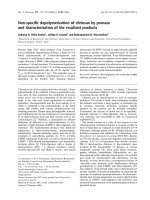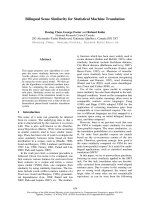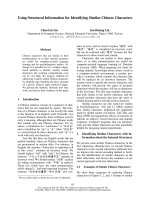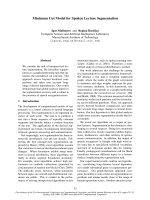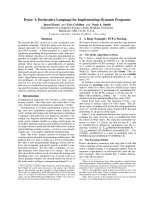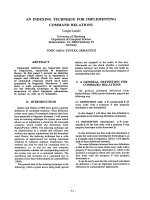Báo cáo khoa học: "Using Leading Text for News Summaries: Evaluation Results and Implications for Commercial Summarization Applications" ppt
Bạn đang xem bản rút gọn của tài liệu. Xem và tải ngay bản đầy đủ của tài liệu tại đây (430.06 KB, 5 trang )
Using Leading Text for News Summaries: Evaluation Results and
Implications for Commercial Summarization Applications
Mark Wasson
LEXIS-NEXIS, a Division of Reed Elsevier plc
9443 Springboro Pike
Miamisburg, Ohio 45342 USA
mark.wasson@lexis-nexis, corn
Abstract
Leading text extracts created to support some
online Boolean retrieval goals are evaluated
for their acceptability as news document
summaries. Results are presented and dis-
cussed from the perspective of commercial
summarization technology needs.
1 Introduction
The Searchable LEAD system creates a Boolean
query aid that helps some online customers limit
their queries to the leading text of news documents.
Customers who limit their Boolean queries to lead-
hag text usually see better precision and an increased
emphasis on documents with major references to
their topics in their retrieval results.
A research team investigating a sentence extraction
approach to news summarization modified Search-
able LEAD to create leading text extracts to use in a
comparison between approaches. Leading text ex-
tracts had a much higher rate of acceptability as
summaries than the team expected. Because that
test was limited to 250 documents, we were not
certain how well leading text would rate as summa-
ties on a larger scale, such as across the NEXIS®
news database. We also could not make any con-
elusive statements about where leading text extracts
routinely fail as summaries for news documents.
This paper presents the results of an investigation
into how Searchable LEAD-based leading text ex-
tracts rate as summaries and where those exWacts
fail. The results support the use of leading text as
general purpose summaries for news documents.
2 Searchable LEAD Overview
Searchable LEAD was originally implemented to
provide LEXIS-NEXIS customers with the means
to limit Boolean queries to key parts of news docu-
ments. It is based on the premise that major entities
and topics of news stories are usually introduced in
the leading portion of news documents. Searchable
LEAD targets the subset of news information cus-
tomers who want to retrieve documents that contain
major references to their targeted topics but not
documents that only mention those topics in passing.
These customers generally can expect higher preci-
sion and lower recall when they restrict their Boo-
lean queries to the headline and leading text than if
they were to apply their queries to the full text.
Documents in our news database have several text
fields including HEADLINE and BODY fields.
Searchable LEAD software identifies the leading
portion of the BODY field and labels it the "LEAD"
field. The amount of the BODY field that is in-
eluded in the LEAD is based on document length.
Minimum thresholds for the number of words, sen-
tences and paragraphs to include in LEADs increase
as document length increases.
In an examination of more than 9,000 news docu-
ments from more than 250 publications, we found
that short documents usually begin with good topic-
summarizing leading sentences, what we call the
logical lead.
Longer documents, however, more
often begin with anecdotal information before pre-
senting the logical lead. LEAD fields must be
longer for these documents in order to include the
logical lead in most instances. Using a fixed
amount of leading text regardless of document
length would have resulted in LEADs that include
1364
too much text beyond the logical lead for shorter
documents, and LEADs that miss the logical lead
entirely for longer documents.
Customers can limit part or all of a Boolean query
to the LEAD, as the following query shows:
LEAD(CLINTON) AND BUDGET
This query will retrieve only those documents that
contain "Clinton" in the LEAD and "budget" any-
where in the document. Customers who use LEAD
routinely combine
it
with the HEADLINE field.
We tested 20 queries on a database that contains 20
million documents from more than I0,000 English
language news publications. Each query was ap-
plied to the HEADLINE and BODY fields (abbre-
viated here as I-IBODY) and to the HEADLINE
and
LEAD fields (I-ILEAD). Queries were limited by
date in order to reduce the magnitude of the evalua-
tion task. In order to obtain a more complete pic-
ture of recall, other queries were used to identify
relevant documents that the tested queries missed.
The results in Table 1 show that limiting Boolean
queries to leading text can help Searchable LEAD's
targeted customers.
Document Average Average
Fields Precision Recall
HLEAD .472 .600
HBODY .208 .793
Average of
F-measures
.432
.288
Table 1. Impact of LEAD Restrictions on Boo-
lean Retrieval Quality (20-query test)
Searchable LEAD document processing software
consists of a 500-statement PL1 program and a 23-
rule sentence and paragraph boundary recognition
grammar, and operates in a mainfiame MVS envi-
ronment. Searchable LEAD processes over 500,000
characters (90 news documents) per CPU second.
3 Related Work
There is a growing body of research into approaches
for generating text summaries, including approaches
based on sentence extraction (Kupiec et al., 1995),
text generation from templates (McKeown
and
Radev, 1995) and machine-assisted abstraction
(Tsou et al., 1992). Brandow et al. (1995) reported
on a sentence extraction approach called the Auto-
marie News Extraction System, or ANES. ANES
combined statistical corpus analysis, signature word
selection and sentence weighting to select sentences
for inclusion in summaries. By varying the number
of sentences selected, ANES-generated extracts
could meet targeted summary lengths.
ANES was evaluated using a corpus of 250 docu-
ments from newswire, magazine and newspaper
publications. ANES was used to generate three
summaries for each document, targeting summary
lengths of 60, 150 and 250 words. For a baseline
comparison, a modified version of the Searchable
LEAD software was used to create three fixed
length leading text summaries for each document,
also targeting lengths of 60, 150 and 250 words.
News analysts read each document and its corre-
sponding summaries, and rated the summaries on
their acceptability. Table 2 shows the results for
each approach. Overall, 74% of the ANES summa-
ries were judged to be acceptable. Unexpectedly,
the acceptability rate for leading text summaries
was significantly higher. Overall, 92% of the lead-
ing text summaries were judged to be acceptable.
Summary ANES Leading Text
Length Acceptable Acceptable
60 words 68% 87%
150 words 76% 93%
250 words 78% 96%
Overall 74% 92%
Table 2. Acceptability Rates Comparison be-
tween ANES and Leading Text
The results for both approaches showed a promising
start towards the goal of creating summaries for
news documents. However, those results also raised
questions about leading text. We wanted to better
understand the value of leading texts as general pur-
pose news document summaries.
4 Methodology
Our investigation had two goals: to verify on a
larger scale the results that Brandow et al. (1995)
suggested for leading text, and to determine whether
there are easily definable indicators of where leading
text extracts fare poorly as general purpose news
document summaries.
1365
We used the Searchable LEAD definition of leading
text as our summaries. The LEAD fields vary in
length based on overall document length, which we
believe helps them capture the logical lead. Also,
LEAD fields already existed in our news documents
in support of another application, Boolean retrieval.
We did not modify Searchable LEAD sottware or
any LEAD fields for this investigation.
The test corpus consisted of 2,727 documents from
more than 100 English language news publications.
Documents were retrieved from our news database
using several queries. Some queries were biased
towards longer documents or to sources that provide
transcripts. We believed that LEADs for such
documents would pose more problems than would
LEADs for typical news stories, based on past in-
formal observations of LEAD fields. Because of
the query bias, the test corpus does not represent our
news database. For example, only 5.5% of the
documents in the test corpus were less than 120
words long, whereas 18% of the documents in our
news database are that short. Newspapers provide
almost 60% of the documents in our news database
but
only a third of the test corpus documents.
In order to investigate where LEADs might fail as
summaries, we assigned attributes to each document
that allowed us to examine various subsets of the
test corpus. Attributes included the following:
• BODY field and LEAD field word counts
Source type (newspaper, wire service, newslet-
ter, magazine, transcript service)
Subject matter (biographical, financial, legal,
legal news, other news, reviews, scientific)
Document type (general news, which includes
standard news articles, graphics, editorials,
LEAD=BODY, letters/Q&A columns, and mu-
sic and book reviews; lists; newsbriefs; and
television program transcripts)
• United States or non-United States source
News analysts read each document and rated
its
corresponding LEAD field on its acceptability as a
general purpose summary for that document. They
rated the LEADs as either acceptable or unaccept-
able. Ratings were linked to document attributes in
an evaluation file that contained one record for each
document. This file was analyzed to obtain de-
scriptive information about the test corpus and to
compare attributes and ratings.
5 Results
Overall, 82.3% of LEADs were rated acceptable as
summaries. However, because of differences be-
tween test corpus content and the content of our
news database, this acceptability rate is not an over-
all indicator for our news database.
Document type was the most distinguishing attrib-
ute for identifying potential problem LEADs. For
the general news document type, 94.1% of LEADs
were rated acceptable as summaries. Acceptability
rates were much lower for lists, newsbriefs and
transcripts, as Table 3 shows.
Document Number of Acceptability
Type Documents Rate
General News 1,951 94.1%
Lists 86 12.8%
Newsbriefs 191 24.6%
Transcripts 499 70.3%
Table 3. Acceptability Rates for Document
Types
The 94.1% acceptability rate for general news
documents is not appreciably different from the
92% average that Brandow et al. (1995) reported.
The results for lists and newsbriefs were not sur-
prising. Such documents seldom have logical leads.
Lists primarily consist of several like items, such as
products and their prices, or companies and corre-
sponding stock quotes. In rare instances, the BODY
of a list type document includes a brief description
of the contents of the list that Searchable LEAD can
capture. In most cases, however, there is nothing
meaningful for any technology to extract.
Newsbrief documents usually consist of several of-
ten unrelated stories combined into one document.
In some newsbrief documents, however, there is an
introduction that Searchable LEAD can exploit.
This was especially tree for newsbrief documents
from wires (67.4% acceptability on 46 documents),
but rarely tree for either magazines (13.8%
accept-
1366
ability on 109 documents) or newspapers (3.1%
acceptability on 32 documents).
LEADs for Wanscript type documents fared some-
what better, with source being a factor for these
also. LEADs for transcripts from transcript sources
were less likely to be rated acceptable (67.8% ac-
ceptability on 435 documents) than those from wires
(90.0% acceptability on 40 documents) or newslet-
ters
(83.3% acceptability
on
24 documents).
Among general news documents, only LEADs for
the review sub-type had a low acceptability rate, as
Table 4 shows.
General News Number of Acceptability
Sub-types Documents Rate
News Articles 1,806 95.5%
Reviews 58 48.3%
All Others 87 95.4%
Table 4. Acceptability Rates for General News
Document Sub-types
The distribution of list, newsbrief and transcript
type documents was often the cause of other appar-
ent problem-indicating attributes. For example, the
overall acceptability rate for LEADs for United
States sources was 80.1% on 2,141 documents,
whereas the overall acceptability rate for non-United
States sources was 90.4% on 586 documents.
When list, newsbrief and transcript documents were
removed, the acceptability rate for United States
sources was 94.5% on 1,391 documents, and the
acceptability rate for non-United States sources was
93.0% on 560 documents.
When examining other general news document at-
tributes, we found that only LEADs for magazines
had a somewhat lower acceptability rate (Fable 5).
Source Number of Acceptability
Type Documents Rate
Magazines 470 88.5%
Newsletters 217 98.2%
Newspapers 880 94.2%
Transcripts 7 100.0%
Wires 377 98.1%
Table 5. Acceptability Rates for General News
by Source Type
The review sub-type was a factor here. Many of
those were from magazines. Excluding those, the
acceptability rate for magazine LEADs climbed to
92.50/0, still lower than for any other source.
Document length was a factor for LEAD accept-
ability for the entire test corpus, but list, newsbrief
and transcript type documents are typically longer
than general news documents. Document length
was less of a factor when looking only at LEADs
for general news documents (Fable 6).
BODY Length Number of Acceptability
Documents Rate
0-119 words 151 97.4%
120-299 words 168 98.2%
300-599 words 312 95.8%
600-1199 words 548 94.9%
1200+ words 772 91.2%
Table 6. Acceptability Rates for General News
by Document Length
The length of the LEAD itself was not tied to ac-
ceptability for either the entire test corpus or the
general news document subset.
6 Discussion
The results of this investigation show that leading
text can provide acceptable summaries for most
general news documents. These results are consis-
tent with Brandow et al. (1995). However, we also
found that leading text is much less likely to provide
acceptable summaries for news documents with
certain structures, including list, newsbrief and tran-
script documents. We identified review type docu-
ments as a problem area, but these represent a small
fraction of news data. More noteworthy was the
observation that almost one of every eight LEADs
for general news documents from magazines were
rated umcc~table as summaries.
Kupiec et al. (1995) compared their trainable
document summarizer results and similar amounts
of leading text to manually constructed keys. The
sentences that their summarizer extracted over-
lapped 42% of the sentences in the keys, compared
to 24% for leading text. Both percentages are much
lower than what Brandow et al. (1995) reported, but
differences between the evaluation approaches used
1367
is the probable reason. Kupiec et al. (1995) noted
that there may be more than one good summary for
a given document, something that a key approach to
evaluation does not capture. Brandow et al. (1995)
found this to be the case for some documents where
all ANES-genemted and leading text summaries
were rated as acceptable. Some differences in re-
suits may also be attributed to the test data used.
Kupiec et al. (1995) used scientific and technical
documents rather than general news.
Leading text extracts such as the LEAD field are
appealing for commercial use as summaries for a
number of reasons. For general news documents,
they are usually acceptable as summaries. They are
easy and inexpensive to create. Leading text ex-
tracts also have two less obvious advantages over
other approaches. First, legal restrictions often pre-
vent us from manipulating copyrighted material.
Leading text extracts often preserve the existing
copyright. Second, when leading text fails as a
summary, customers can see why. Customer un-
derstanding of how a data feature is created is often
key to customer acceptance of that feature.
There are, however, a number of reasons why we
need to consider alternatives to leading text. First,
not all documents have a logical lead that can be
exploited. In this investigation, we found that to be
the case for most list and newsbrief documents and
for many transcripts. Beyond news data, this holds
for case law documents, many types of financial
documents, and others.
Second, a static summary such as one based on
leading text represents a "one size fits all" approach
to summarization. Readers bring their own interests
to documents. A dynamic summary generator, per-
haps using readers' queries to guide it, can help
readers focus on those parts of a document that are
most relevant to them.
Third, a hybrid approach to summary generation
may improve acceptability for news documents.
Lin & Hovy (1997) describe methods for identifying
the likely locations of topic-bearing sentences.
Comparing the content of leading text extracts to
predictions of topic-bearing sentences may help us
predict where leading text fails as a summary so
that we can direct more sophisticated approaches to
those documents.
The commercial use of leading text summaries such
as Searchable LEAD by no means suggests that
news summarization is a solved problem. There are
a number of
data types
where leading text has di-
minished or no value as a summary. Where it does
succeed, an approach like Searchable LEAD may
serve as a starting point for improved leading text
summaries or as a benchmark for comparing alter-
natives that are not restricted by the limits inherent
in leading text approaches to summarization.
Acknowledgments
I would like to thank colleagues Christi Wilson and
David Schmeer for reading, rating and assigning
attributes to the 2,727 test corpus documents and
LEADs. I would also like to thank Breck Baldwin,
Afsar Parhizgar, David Schmeer and Paul Zhang
for their comments and suggestions.
References
Brandow, R., Mitze, K. and Rau, L. (1995)
Auto-
matic Condensation of Electronic PubBcatJons
by Sentence Selecaon.
Information Processing &
Management, 31/5, pp. 675-685.
Kupiec, J., Pedersen, J., and Chert, F. (1995) A
Trainable Document Summarizer.
Proceedings
of the 18th Annual International ACM SIGIR
Conference on Research and Development in In-
formation Retrieval, pp. 68-73.
Lin, C Y., and Hovy, E. (1997)
Identifying Topics
by Posiaon.
Proceedings of the Fifth Conference
on Applied Natural Language Processing, pp.
283-290.
McKeown, K., and Radev, D. (1995).
Generaang
Summaries of Multiple News Articles.
Proceed-
ings of the 18th Annual International ACM SlGIR
Conference on Research and Development in In-
formation Retrieval, pp. 74-82.
Tsou, B., Ho, H C., Lai, T., Lun, C., and Lin, H
L. (1992)
A Knowledge-based Machine-aided
System for Chinese Text Abstraction.
COLING-
92 Proceedings, pp. 1039-1042.
1368
